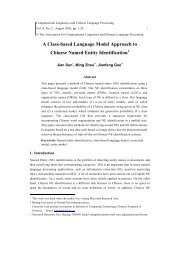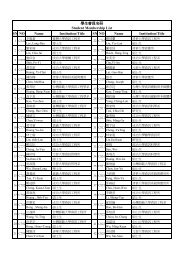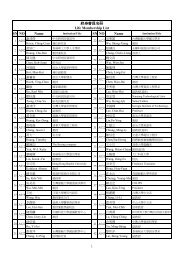Machine Translation Approaches and Survey for Indian ... - aclclp
Machine Translation Approaches and Survey for Indian ... - aclclp
Machine Translation Approaches and Survey for Indian ... - aclclp
Create successful ePaper yourself
Turn your PDF publications into a flip-book with our unique Google optimized e-Paper software.
<strong>Machine</strong> <strong>Translation</strong> <strong>Approaches</strong> <strong>and</strong> <strong>Survey</strong> <strong>for</strong> <strong>Indian</strong> Languages 55well with local phrase orders but not as well with long sentences <strong>and</strong> complex orders.3.2.3 Hierarchical Phrase Based modelBy considering the drawback of previous two methods, Chiang (2005) developed a moresophisticated SMT approach, called the hierarchical phrase based model. The advantage ofthis approach is that hierarchical phrases have recursive structures instead of simple phrases.This higher level of abstraction approach further improved the accuracy of the SMT system.3.3 Hybrid-based <strong>Translation</strong>By taking the advantage of both statistical <strong>and</strong> rule-based translation methodologies, a newapproach was developed, called hybrid-based approach, which has proven to have betterefficiency in the area of MT systems. At present, several governmental <strong>and</strong> private based MTsectors use this hybrid-based approach to develop translation from source to target language,which is based on both rules <strong>and</strong> statistics. The hybrid approach can be used in a number ofdifferent ways. In some cases, translations are per<strong>for</strong>med in the first stage using a rule-basedapproach followed by adjusting or correcting the output using statistical in<strong>for</strong>mation. In theother way, rules are used to pre-process the input data as well as post-process the statisticaloutput of a statistical-based translation system. This technique is better than the previous <strong>and</strong>has more power, flexibility, <strong>and</strong> control in translation.Hybrid approaches integrating more than one MT paradigm are receiving increasingattention. The METIS-II MT system is an example of hybridization around the EBMTframework; it avoids the usual need <strong>for</strong> parallel corpora by using a bilingual dictionary(similar to that found in most RBMT systems) <strong>and</strong> a monolingual corpus in the TL (Dirix etal., 2005). An example of hybridization around the rule-based paradigm is given by Oepen. Itintegrates statistical methods within an RBMT system to choose the best translation from a setof competing hypotheses (translations) generated using rule-based methods (Oepen et al.,2007).In SMT, Koehn <strong>and</strong> Hoang integrate additional annotations at the word-level into thetranslation models in order to better learn some aspects of the translation that are bestexplained on a morphological, syntactic, or semantic level (Koehn et al., 2007). Hybridizationaround the statistical approach to MT is provided by Groves <strong>and</strong> Way; they combine bothcorpus-based methods into a single MT system by incorporating phrases (sub-sententialchunks) from both EBMT <strong>and</strong> SMT into an SMT system (Groves et al., 2005). A differenthybridization happens when an RBMT system <strong>and</strong> an SMT system are used in a cascade;Simard proposed an approach, analogous to that by Dugast, using an SMT system as anautomatic post-editor of the translations produced by an RBMT system (Simard et al., 2007)(Dugast et al., 2007).









